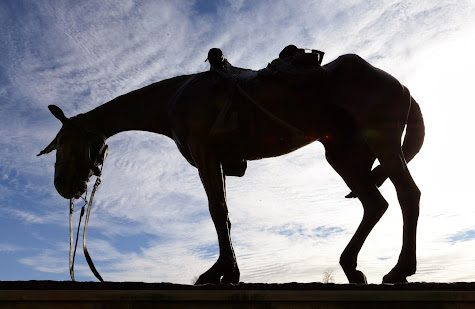3 million horses and mules served.
 |
| "Still ready to do his duty" Those Bridled Soldiers of the Civil War |
"In war, horses are the noblest of creatures. They endure the hardships of battle and the chaos of the battlefield with a grace and courage that is unmatched." — (Michael Morpurgo, War Horse) [1]
In the annals of Civil War history, the spotlight often shines on the valiant soldiers, the strategic leaders, and the burgeoning power of industrialization that shaped the course of America's first truly modern conflict. But beneath this human-centered narrative lies another story—one of tireless, loyal, and indispensable companions who also shared the hardships of war: the horses. Morpurgo called them, "the noblest of creatures" because they, too, endured "the hardships of battle and the chaos of the battlefield with a grace and courage that is unmatched." [1]
These equine heroes, however, are often overlooked in the grand narratives of war. Yet, their contributions were multifaceted and critical to the war effort. Author Allie Lynn aptly calls the Civil War "The Horse's War." And it was. Horses and mules served valiantly in every military capacity, from the swift cavalry units and steadfast artillery teams to the essential supply trains and reliable couriers, and even in the infantry as they carried ranking officers on campaign trails and battlefields and the wounded soldiers away from them. They endured harsh conditions, battlefield chaos, and fatigue, yet remained steadfast in their service. [2]
John Cockerill of the 70th Ohio Volunteer Infantry Regiment described the heartbreaking sight of wounded horses after the Battle of Shiloh: "Here and there in the field, standing in the mud, were… poor wounded horses, their heads drooping, their eyes glassy and gummy, waiting for the slow coming of death." [3]
This point is brought into even sharper focus when we consider the following statistics:
During the American Civil War, of the 3 million horses and mules that served, approximately 1.5 million (or half) of them died. By comparison, 2.75 million people served in the war, and between 620,000 to 700,000 died. [4]
Despite their comprehensive involvement and extraordinary service in the war, mankind has often and arrogantly dismissed the historical role of their fellow creatures as a sort of "divine gift" meant for us to exploit without thought or acknowledgment of their suffering, pain, or even their importance. The harsh realities and abuses they faced during this tumultuous period were stunning.[5]
The horses were worked hard and long. The stakes were high, and the horses paid the price. A man on a long, hot march, pushed beyond what his body could bear, might drop out temporarily and catch up with his company later. Horses had no such choice. Ridden or harnessed to the wagons and limbers, they galloped or pulled until they fell or - as happened in most instances - until they harmed their bodies beyond healing, and then were shot. [6]
Captain Charles Francis Adams (1st Massachusetts Cavalry Regiment) wrote to his mother on May 12, 1863, and described the magnitude of what was happening to the animals:
“The air of Virginia is literally burdened today with the stench of dead horses, federal and confederate. You pass them on every road and find them in every field, while from their carrions you can follow the march of every army that moves.”[7]
 |
| "Bridled Veterans" Horses and Mules Memorial, Middleburg VA (sculpture by Tess Pullen) |
This was one of the millions of forgotten stories from the Irrepressible Conflict.
Mac
═══ ⚔ 𝑻𝒂𝒌𝒆 𝒕𝒉𝒆 𝑪𝒐𝒍𝒐𝒓𝒔 ⚑ ═══
[**] In 1997, Paul Mellon, a wealthy horse breeder, thought it unfair that Civil War soldiers had thousands of monuments, but Civil War horses had none. So in 1997, he commissioned English sculptor, Tessa Pullan, to create three of them. These three memorials (done in two different sizes) have been distributed around the country at these sites: National Sporting Library (Middleburg VA), Ft. Riley KS, and the Virginia Historical Society (Richmond VA). In Richmond, the statue sits in front of the historical society building, and at night, when the front of the building is lit up, the statue casts a huge silhouette against the large white marbled building. It's impressive.
No comments:
Post a Comment